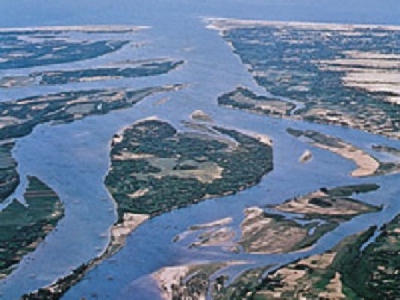
Posted on September 19, 2016
Rivers and canals in the southwestern region are becoming depleted as they are not regularly dredged and cleared, and are encroached upon by people’s housing.
There are 26 seaports, big and small in Mekong Delta. The dredging capability and canal network in the region are factors that determine the scale and capacity of the ports.
However, the river and canal dredging and maintenance are ineffective, which has resulted in river and canal sedimentation, thus badly affecting the region’s waterways transport.
The Vietnam Maritime Bureau (Vinamarine) believes that the asynchrony between harbors’ scale and passage to ports is the biggest problem of the seaports in Mekong Delta.
The natural stream altitudes of the Tieu Estuary on Tien River, Dinh An & Tran De Estuaries on Hau River, Bo De Estuary on Cua Lon River and other estuaries only allow 1,000-2,000 DWT full-load vessels and 3,000-5,000 DWT offloading vessels, which take advantage of high tides to operate.
Rivers and canals in the southwestern region are becoming depleted as they are not regularly dredged and cleared, and are encroached upon by people’s housing.
The World Bank recommended that the State keep maintaining and dredging the passages regularly, which costs $2 million per annum per one kilometer. However, the work has faced obstacles due to insufficient budget.
While the sedimentation makes river passages shallow, the transport density is relatively high, which has caused overloading. On the Cho Lach – Mang Thit river route, for example, the waterway transport often gets stuck because of bulk cargo and sand carrying vessels which wait for high tide.
“Waterway transport vehicles run aground because the passages cannot be dredged every year,” an official from the Ministry of Transport said.
According to the official, in the last 13 years of exploitation, only 250,000 cubic meters of passage have been dredged and maintained.
This explains why the volume of goods going through the ports in Mekong Delta has been modest in recent years, about 6.5-8.5 million tons a year.
In 2015, the figure was 9.4 million tons. However, the ports there could only serve 20-25 percent of total goods in the region, while the other 80 percent had to go through ports in the eastern part of the southern region.
Meanwhile, Mekong Delta has large ports that can satisfy the demand, but they remain ineffective. Cai Cui Port in Can Tho City, built in 2006, for example, is capable of receiving 20,000 DWT vessels, but it depends on Quan Chanh Bo Canal.
In the region, Vinh Te, about 90 kilometers in length, is one of the most important canals which brings water from Hau River to the whole Long Xuyen quadruple. However, it has also been narrowed because of poor maintenance.
Source: Hellenic Shipping News





